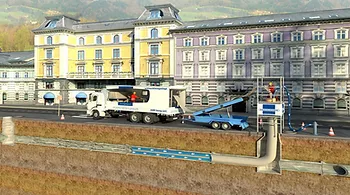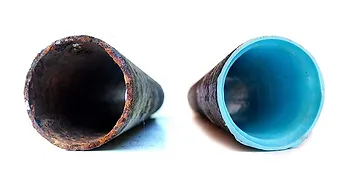What is Sliplining?
Sliplining is a general term used to describe methods of lining with continuous pipes and lining with discrete pipes. Sliplining is also defined as the insertion of a new pipe by pulling or pushing it into the existing pipe and grouting the annular space. After it is in place, the pipe is grouted to hold the lining in place and for additional rigidity. It is used to seal leaks in mostly straight application.
straight application.
Though sliplining can be employed in virtually any size pipe, its use is limited in pipes where there are large obstructions or sharp bends. The rigidity of some liners and grouts allow for structural renovation of the pipe as well.
Polyurethane (HDPE and PE) and polyvinyl (PVS) are the most commonly used lining materials. For glass reinforced pipe (GRP) liners, segmental sliplining is used. Each segment is lowered into position, then jacked into position by machinery.
What is CIPP lining?
Cured in place pipe lining, or CIPP lining, is a trenchless pipe rehabilitation method used to repair existing pipelines. It is a jointless, seamless pipe lining within an existing pipe. The process of CIPP lining involves inserting and running a felt lining into a preexisting pipe that is the subject of repair. Resin within the liner is then exposed to a curing element to make it attach to the inner walls of the pipe. Once, fully cured, the lining now acts as a new pipeline.
As one of the most widely used rehabilitation methods, CIPP lining has applications in sewer, water, gas, and chemical pipelines. The coating place inside the pipe system provides a damp-proof, corrosion resistant, wear-resistant, and non-corrosive lining. Several coats can be applied to the same pipe. This ensures that the system is fully protected and strengthened. The powerful coating enhances the longevity of the pipe. On average, the lining is made to last up to 100 years.
damp-proof, corrosion resistant, wear-resistant, and non-corrosive lining. Several coats can be applied to the same pipe. This ensures that the system is fully protected and strengthened. The powerful coating enhances the longevity of the pipe. On average, the lining is made to last up to 100 years.
Sliplining vs CIPP Lining :
At the core sliplining and CIPP lining are a very similar process. They both install a new pipe inside your old pipe and give you a functional new pipe without having to dig up your old one. Considered trenchless pipe repair, CIPP lining or sliplining are great for your landscape and finances. However, CIPP lining is the preferred method for several reasons.
Sliplining is Grouted
Sliplining involves threading a smaller pipe through your existing one, or "host", pipe. The ends are then sealed with a grout so that there's only one solid line between the old pipe and new entrance. This seal is heavy and may pose difficulty if it breaks down.
CIPP Lining
CIPP lining, or cured in place pipe lining, enters the host pipe as a flexible felt liner soaked in a mixture of epoxy resin. This allows it to conform to the shape of your host pipe. If your pipe has suffered some pressure and is no longer perfectly round, CIPP lining can adapt to the shape that it is. Once the liner is in place, hot air is forced through the length of the pipe. It easily hardens into a brand new pipe.
Difference between CIPP lining and Sliplining :
- Sliplining puts an entire already made pipe inside your other pipe. This pipe has less flexibility than a cured in place pipe. It's also more difficult to get a custom size of premade pipe than it is to make a custom size felt liner. If your pipes are of unusual size, it may be more difficult to slipline them than to have CIPP liner installed.
- CIPP liner doesn't rely on grout to form a seal around the pipe. CIPP liner doesn't have to be flush with the host pipe to be effective. This allows smaller access ports for CIPP liner installations.
- Sliplining pre-dates CIPP lining. Sliplining got started in the 1940s, while CIPP lining didn't come along until 30 years later, beginning in the 1970s.
- CIPP technology is more up to date. It uses technology that wasn't around when sliplining became popular.
- One drawback of sliplining is that you be losing a lot of the space in your pipe. Sliplining requires a lot of space to work. This drastically reduces the size of the pipe that you have to work with. Many industrial sites can't afford to lose that amount of space that sliplining gives up. CIPP lining, on the other hand, is much thinner. The resulting pipe is strong enough that you can get a large, strong pipe that's only 1/4 to 1/2 inches thick.
- In the end, CIPP lining and sliplining have the goal of trenchless pipe repair. However, CIPP lining is a more modern, flexible process that requires less work. Moreover, it lets you keep your pipes closer to their original size.
Hire a Professional Trenchless Pipe Lining Company Today
With cured in place pipe lining and trenchless pipe lining options, your project gets done quickly, with precision, and reduces damage and disruption to the surrounding areas. If you have further questions about cured in place pipe lining or other trenchless pipe lining options, give us a call at Wind River Environmental. We are equipped to handle all your trenchless pipe repair needs.

